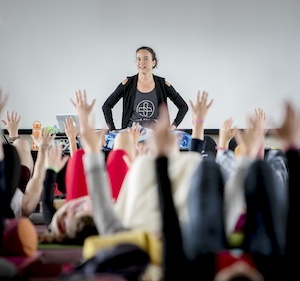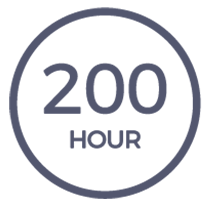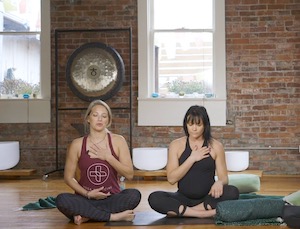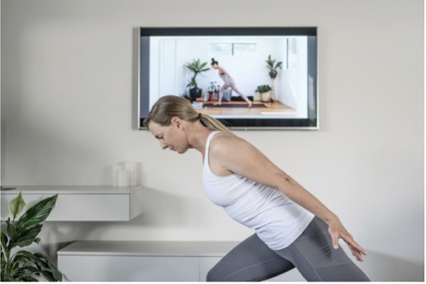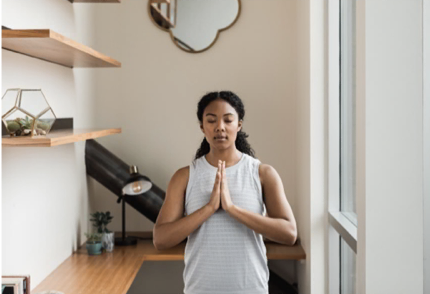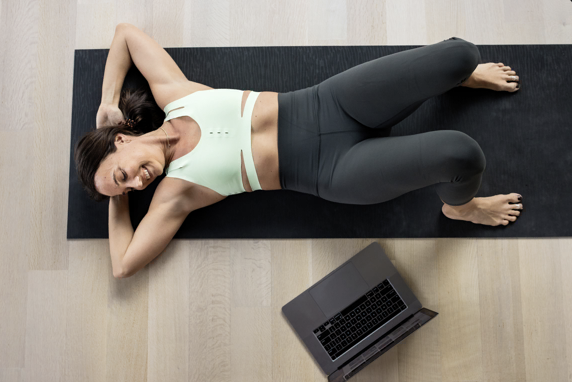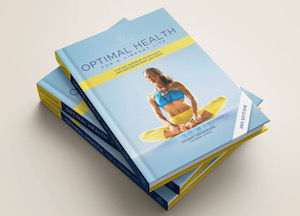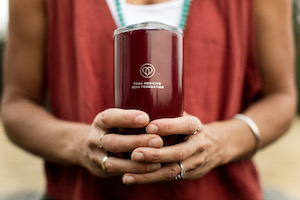Anatomy, Articles, In the Press, Resources, Yoga Medicine® News
The Interconnection of the Body’s Domes
By Katharina Claeys for Yoga Medicine.

Are you living your life on autopilot? Going about your to-do-list doing the school run and running late for work or dinner plans?
We miss the opportunity to check in and hear from our bodies in terms of how we really feel – until the cup overflows and issues start to surface.
This article provides background on the anatomy and functions of the different domes or diaphragms of the body. It demonstrates the importance of maintaining a good balance throughout the body and proposing therapeutic yoga practices to support a healthy body.
The Domes/Diaphragms of the Body
Firstly, there is the misconception of the pelvic floor being a hammock or basin, shaped like a bowl. However, researchers in the late 90s realized that the pelvic floor is rather a dome, like the respiratory diaphragm. It mimics the thoracic diaphragm on inspiration. During inhalation the pelvic floor flattens and during exhalation it relaxes and regains its dome shape.
Click here to view the Diaphragm Sketch
Here is a list from top to bottom:
- Cranial diaphragm – tentorium cerebelli: Cranial structures that move in relation to breathing to regulate cerebrospinal fluid flow.
- Upper cervical diaphragm – palate: Consisting of tongue, floor and roof of the mouth and hyoid musculature.
- Lower cervical diaphragm – thoracic outlet: Breathing muscles assist the airways to be open and increase lung capacity.
- Thoracic diaphragm – respiratory diaphragm: This thin muscle separates the lungs from the abdominal cavity and descends during respiration to allow air to fill the lungs when inhaling and springs back on exhalation.
- Pelvic diaphragm – pelvic floor: The pelvic floor muscles hold the bladder, intestines and reproductive organs. The pelvis functions through the direct intertwined connection to the respiratory diaphragm simultaneously with respiration.
- Foot diaphragm – arches of the feet: The feet directly affect the pelvic floor, the deep core, and the respiratory diaphragm via the fascia.
The diaphragms of the body are deeply connected with one-another and aid to move gases, body fluids and act as internal pumps to help organs work efficiently. They influence each other through neurological, facial and anatomical connections. Some examples are:
- The respiratory diaphragm and pelvic floor support the efficient movement of body fluids in the abdominal cavity and support in peristalsis of the intestine.
- Respiration affects the breathing muscles: the thoracic outlet. The palate and cranial diaphragm move in relation to the breathing to support cerebral spinal fluid movement around the brain. It then moves into the brain stem, affecting the entire body through the nervous system, resulting in more balance and relaxation.
When the Cup Overflows
Think about a tree and the interconnection between the roots, and the branches and leaves. Nourishing the roots will result in healthy leaves and quality fruit.
The human body isn’t very different. Any changes in one area of the body may have effects on another. It is therefore necessary to understand how muscles in different parts of the body communicate with each other and as well as understanding the mechanics that connect them.
There is an immediate effect on the pelvic floor from the thoracic diaphragm (e.g. when coughing or sneezing). This effect may very likely go unnoticed in a healthy body. An out of balance body could experience leakage (a few drops or more). The common belief that this is normal, especially in older age, is a misconception.
Poor breathing not only affects the thoracic diaphragm, but also causes tension in the mid back, neck and jaw, which could lead to a variety of other ailments such as tension or dysfunction of the pelvic floor. Furthermore, a dysfunctional thoracic diaphragm, tight neck and jaw muscles, and stress affect the vagus nerve (the 10th cranial nerve /vagal nerve). This causes the nervous system to stay in the sympathetic (fight and flight) state for an unhealthy long period as opposed to the parasympathetic (rest and digest) state.
Where to Go from Here?
Correct breathing through the nose and a good posture (standing/sitting) benefit the diaphragms of the body tremendously.
The following practices are aimed at supporting the whole body and its diaphragms. Those practices contain variations and modifications, which the yogic practitioner might not yet have tried. I encourage those practitioners to meet the new experiences with curiosity and an open mind. The following postures and pranayama practices can be done in the order of preference or in a sequence.
1. MFR: Rolling the Feet


Useful for: MFR (myofascial release) for the feet to enhance the facial interconnection throughout the body, also supporting the health of all the other diaphragms.
Props: MFR ball or tennis ball
How to practice:
- Stand upright and start with one foot. Start by with pressing (medium pressure) into the dome/arch of the foot (middle). Press gently in and out. Hold for a moment, lingering into the gentle pressure.
- Now, start rolling in one direction (from the ball of the foot to the heel) to support fluid return and to sense the textures and finish with a light scribble.
- Try and be curious about the sensations by rolling more the inner foot and outer foot.
- Afterwards, notice the shift of body weight and other sensations by standing up straight/statically and gently sway to the left and right. What do you feel? How does this foot, leg, side of your body feels compared to the other side?
- Repeat on the second side: notice what feels different from side to side, what feels the same.
Duration: 3-5 minutes per foot
Modification: Practice sitting on a chair
2. Mountain Pose – Tadasana


Useful for: An important pose which can improve the posture. There are many ways to practice Tadasana and a good way to connect feet, legs and pelvic floor is to practice this pose whilst holding a yoga block between the upper thighs. If you have rather flat feet, the block may be instead placed between the calves. This variation teaches a neutral position of the spine and pelvis, resulting in maximized pelvic floor muscle function.
Props: Yoga block
How to practice:
- Stand up straight with feet slightly apart.
- Place a yoga block on its narrowest width between the upper inner thighs.
- Weight evenly distributed between the feet from side to side, but with slightly more weight in the heels than in the balls of the feet.
- Find a neutral position so the center of the perineum is parallel to the floor and in line with the crown of the head.
- Rotate the thighs slightly inward – it will roll the block back and will create space on the sides of the tailbone and spread the sitting bones.
- Release the top rim of the buttocks down, away from the lower back. This should be a release, not a tucking action!
- Lift the quadriceps muscles to lift the kneecaps, which will move the thighbones deeper toward the back of the legs (hamstrings).
- Pause here and notice how the breath changes with these actions and how it might feel different to a Tadasana practiced without blocks.
- Reminder: Keep the crown of the head lifted and place the arms at either side. The palms face the thighs, fingers together. Lengthen the arm toward the ground.
Duration: from 1–5 minutes – this pose requires effort, so keep it easy if it’s your first time
Modification: Practicing the pose with the back against a wall will help you achieve and feel the proper alignment.
3. Downward Facing Dog – Adho Mukha Svanasana

Useful for: Hip flexion (forward bend) typically pulls on the ischial tuberosities (sitting bones) if the hamstrings are tight. This leads to difficulty lifting the sitting bones and tailbone. To be able to stretch the pelvic floor muscles (the aim here), bend the knees. This enables the hamstrings to relax and then to untuck the pelvis.
Props: Yoga blocks (for the hands; optional) or yoga chair (if not tolerant to bare weight on hands)
How to practice:
- Start in table top. Tuck the toes and lift the knees off the floor into DFD.
- Strongly pull the hips away from the hands. Extend through the tail and sitting bones, lifting them toward the ceiling.
- Push the thighbones back by engaging the quadriceps (front of the thigh) and draw the pelvis away from the torso and bend the knees. The bend in the knees slackens the hamstrings and brings concavity to the lumbar spine. This enables the tailbone and sitting bones to move away from the shoulders and toward the ceiling.
- Spread the fingers and ground down into the hands, especially into the thumb mound and root of the index finger.
- Keep the ears in line with the inner arms. If you tend to have a tense jaw and neck, gently shake the head from side to side and loosen the jaw muscles until you find a neutral position.
- Rotate the thighs inward and push the hips up toward the ceiling and away from the arms.
- Exit by bending the knees and rest in child’s pose.
Duration: 20 seconds to 2 minutes – start slowly if you’re doing this variation for the first time
Modification: Use blocks under the hands or a chair to rest the main weight on.
4. Child’s Pose – Balasana

Useful for: This pose is a forward fold and resting pose. Generally it can be done without any props. The stretch of the pelvic floor muscles can be better supported by practicing this pose with the sides of the torso resting on a bolster and the big toes slightly apart. The sitting bones should point away from the crown of the head (not down toward the floor). Test the amount of support on the top of the heels that your body needs to achieve this.
Props: Bolster, two blocks and one or two blankets (for e.g. knee cushioning and one between buttocks and heels)
How to practice:
- Place the big toes 2 inches away from each other and bring the knees slightly wider than hip distance apart. Place the folded blanket on the heels. The bolster supports the ribcage but does not restrict the movement of the breath in the abdomen.
- Walk the hands forward (with or without the blocks) and rest the forehead on the bolster (folded towel for the forehead to keep the head straight (e.g. neck pain) or to a preferred side).
- Rest here for 1 minute.
- Now gently press the hands into the blocks and focus your attention on the breath.
- With each inhalation, let the breath come to the sacrum and the back of the pelvic floor. With each exhalation, visualize unwanted tension leaving the body.
- Then shift the focus of the breath to the lower back and breathe here until walking up to the mid back.
- Stay as long as you like.
- To get out of this pose, walk the hands in, until they are in front of the knees and push into the hands and arms to come up.
Duration: 1-5 minutes
5. Ujjayi Breathing Practice – Pranayama

Useful for: Practice the Ujjayi breath with a focus on the pelvic floor. Imagine you could breathe from the pelvic floor to the collar bones. Imagine your breath expanding lengthwise with the inhalation. Drawing back inward on the exhalation.
Sense the breath expanding three-dimensionally through the body – front and back. Allow yourself just being at 60%, effortless and at ease. Stay here as long as you want or combine it with a wonderful humming practice to connect the pelvic floor further up until the palate diaphragm – the roof of the mouth and tongue.
Duration: 2-10 minutes, or as long as desired
6. MFR Practice for the SCM

Useful for: The scalene muscles are three paired muscles (anterior, middle and posterior), located in the lateral aspect of the neck. This area is usually quite sensitive, since the vascular area becomes more superficial. Therefore, this practice is supposed to be gentle, especially for senior citizens or those with underlying health issues. This MFR practice shows a safe way to work on the SCM (sternocleidomastoid muscle) which often tense to be rather tight. Practice this on both sides of the body.
Props: None needed
How to practice:
- Locate the SC joint (where the clavicle meets the sternum) on the right side of the body. Place the right hand with the flat palm (note: you can choose either hand) on this joint. The other palm comes on top of it.
- Push gently in to maintain the skin contact, tractioning it down.
- Bring the head up, extend it and turn the head away to the opposite side, to turn away from that joint.
- Feel the sensation here. If comfortable, continue by moving your chin and jaw around and find a good angle to linger.
- Stay for a few breaths and come back up gently.
- Repeat on the other side.
Duration: 1-3 minutes
7. Ear Unfurling – (Auricle) Ear Massage

Useful for: The medical term for the outer ear is the auricle or pinna. Massaging or unfurling, as it is called in the practice of Touch for Health/Kinesiology, can be a great way to release tension of the neck and face and increase flexibility and range of motion in these areas.
Unfurling the ears is a massage technique, which can be done at any time of the day. It stimulates the acupuncture meridians in the body. It is highly recommended to massage both ears. Both ears can be massaged simultaneously or one after the other.
Props: None needed
How to practice:
- Find a comfortable seat (or even stand) and keep the head and neck neutral and straight (note: the picture shows a turned head for clear instruction).
- Turn the head gently to the right and left and evaluate the discomfort and flexibility before the practice.
- Start at the top of the outer ear and fold and pull it slowly and firmly away from the opening of the ear.
- Continue around and down to the ear lobe. Some acupressure points may feel sore. Continue to massage and unfurl the ear auricle. Give the sore points some extra love and attention by lingering longer and giving them an extra rub/tug/unfurl.
- Stay at the ear lobe, pull it gently down and hold for 3 seconds. Then let your fingers slide off of it.
- Check your breath, ongoing emotions, and sensations in the neck, jaw and face. Then turn your head and notice any changes such as an increase in flexibility and/or range of motion.
- Repeat on the second side if not done simultaneously.
Duration: 3-5 minutes, depending if sides are done simultaneously
More Resources with Yoga Medicine:
- As mentioned above, the 360 degree breath is a very beneficial pranayama practice for the pelvic floor and the other domes of the body. I particularly like one by Tiffany Cruikshank at Yoga Medicine Online.
References
- Bordoni, B. (2020): The Five Diaphragms in Osteopathic Manipulative Medicine: Myofascial Relationships, Part 1. Cureus, 12(4): e7794.
- Bordoni, B; Zanier, E. (2015): The continuity of the body: hypothesis of treatment of the five diaphragms. Journal Alternative Complement Medicine. Pages 237-242.
- Hjartardottir, S; Nilsson, J.; Petersen, C., Lingman, G. (1997): The female pelvic floor: a dome –not a basin. Acta Obstetricia et Gynecologica Scandinavica. Vol. 76. Issue 6. Jun 1997. Pages 495-611. https://obgyn.onlinelibrary.wiley.com/doi/epdf/10.3109/00016349709024586, last accessed 23.10.2024
- Howard, Leslie (2017): Pelvic Liberation: Using Yoga, Self-Inquiry, and Breath Awareness for Pelvic Health. Leslie Howard Yoga (Publisher).
- Myers, Thomas W. (2020): Anatomy Trains: Myofascial Meridians for Manual Therapists and Movement Professionals. Elsevier (Publisher).
- Park, H.; Han, D. (2015): The effect of the correlation between the contraction of the pelvic floor muscles and diaphragmatic motion during breathing. Journal of Physical Therapy Science Jul; 27(7). Pages 2113-2115.
About the Author

Katharina Claeys is an experienced and registered RYT 500, RPYT, RCYT, baby yoga teacher and Yoga Medicine® Therapeutic Specialist specializing in women’s and children’s health and corporate yoga.
By giving every student the space, respect and attention they deserve, she is committed to the growth of her clients and teaches with the hope that each student will find the spark they need to stay mindful, curious and inspired during their time on and off the mat. Breathing exercises (pranayama), myofascial release techniques (MFR) mindful practices and meditations are a key aspect of her classes. In her 1:1 sessions, Katharina creates individualized therapeutic yoga practices whatever health concern or age. She emphasizes on optimizing physical and physiological function by combining anatomy, physiology, mental health, in relation to modern science and research.
Links
Website: https://www.katharinaclaeys.com
Instagram: https://instagram.com/katharina.claeys.yoga and https://instagram.com/yoganestling
LinkedIn: https://de.linkedin.com/in/katharina-claeys-548526184
Insight Timer: https://insighttimer.com/katharinaclaeys

